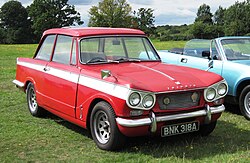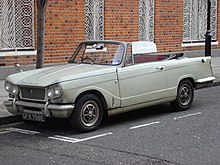Triumph Vitesse
| triumph | |
|---|---|
|
Triumph Vitesse 1600 (1963)
|
|
| Vitesse | |
| Production period: | 1962-1971 |
| Class : | Middle class |
| Body versions : | Limousine , cabriolet |
| Engines: |
Petrol engines : 1.6–2.0 liters (51–76.5 kW) |
| Length: | 3886 mm |
| Width: | 1524 mm |
| Height: | 1334 mm |
| Wheelbase : | 2324 mm |
| Empty weight : | 876-940 kg |
| Previous model | Triumph Mayflower |
| successor | Triumph Dolomite |
The Triumph Vitesse is a small six-cylinder sports car that Triumph built from 1962 to 1971. The Triumph Vitesse is based on the Triumph Herald published in 1959. The Vitesse emerged from an initiative of the then Standard Triumph boss Henry George Webster , who had a Triumph Herald equipped with a standard Vanguard engine. Under the project name “Atom”, the Triumph-internally called “Kenilworth Dragster” was created with a six-cylinder engine, the body of which was designed by the Italian designer Giovanni Michelotti on the basis of the Herald body. It was available as a sedan, convertible and, in very small numbers, as a station wagon ("Estate").
The name Vitesse was already used by Triumph for a model made in 1937 and 1938 before the Second World War .
Vitesse 6
The Triumph Vitesse 6 was introduced on May 25, 1962. It was the high-performance variant of the Herald small two-door sedan . The Herald was introduced on April 22, 1959. Its shape also came from Michelotti. In the early 1960s, Triumph considered building a small sports sedan with a six-cylinder engine on its basis. Michelotti was again commissioned with the styling and presented a car in which almost all of the Herald's body panels were used and which was equipped with a new vehicle front. The front of the vehicle with its offset twin headlights was called the “Chinese Eye”.
Standard Triumph built the known in-line six-cylinder engine having 1,596 cc from the standard Vanguard Six, but smaller bore of 66.75 mm mm in Vanguard and double instead of 74.7 Solex - downdraft gasifiers B32PIH. These carburetors were replaced by B321H carburetors soon after the car was introduced, as the acceleration pump became a problem. If you look closely at the machine, you will discover a seam on the cylinder block between the third and fourth cylinder, which indicates the beginnings of this engine design as the 803 cm³ engine block of the Standard Eight from 1953. The manual gearbox was reinforced and offered with an overdrive from Laycock-de-Normanville , D-type . Front disc brakes and more powerful rear drum brakes were offered as standard, and the Herald's tank was enlarged while retaining the reserve cock of the smaller tank. Due to the heavier weight of the six-cylinder engine, the front suspension was equipped with stronger coil springs; on the rear axle, the system was adopted from the Herald with pendulum axle and transverse leaf spring, but soon proved to be unsuitable for the more powerful Vitesse. The chassis essentially corresponded to that of the Herald. A sedan and a convertible were available; a coupé that was also designed was never ready for series production. A handful of station wagons was also created at the special customer request in the Standard-Triumph service depot in Park Royal in west London.
The interior has been upgraded compared to the Herald, interior door panels made of wood matched the wooden dashboard; the car also had better seats and door controls. A Webasto sunroof in vinyl or fabric was available as an extra in the limousine . Outside there were stainless steel trim strips on the sides of the vehicle and aluminum bumper strips (instead of the white rubber strips on the Herald). The side trim strips extend over the entire length of the vehicle and are also guided around the radiator grille.
About a year after it was launched, the Vitesse's styling was redesigned for the first time; the dashboard received several round instruments instead of the single one from the Herald and from September 1965, from chassis number HB27986, the Solex double carburetors were replaced by Zenith-Stromberg CD 150. Before the engine 70 hp (51 kW) was at 5,000 min -1 made and delivered 125 Nm torque. Now the values have increased sufficiently to make the car more flexible and efficient than before. There were 13-14 bhp (9.6-10.3 kW) increase in power indicated, which was a bit too optimistic, but a motor magazine determined the top speed to 146 km / h; the acceleration from 0 to 130 km / h was accomplished in 33.6 seconds instead of 46.6 seconds.
The Vitesse 6 sold extremely well and was the most popular Vitesse model. The car was very popular for its good performance and economical use of petrol, as well as for its elegant interior. The Vitesse had few competitors: its performance matched that of many sports cars (Triumph called it the "Two-Seater-Beater"), but it offered space for the whole family. In particular, the convertible was on the market without competitors until the Stag from the same company appeared many years later .
Sports 6
The Vitesse 6 convertible was also exported to the USA from 1962 to 1964; the left-hand drive version was called Triumph Sports 6 and was marketed as a "Limited Edition" (special model). Because of its high price, only 679 units were sold.
The Sports 6 was probably better suited for the US highways than the Herald, but faced ruinous price competition from cars like the Ford Mustang . The Vitesse sedan was not officially sold in the US, although some examples were privately imported, usually by American service personnel. The official retail price for the Sports 6 Cabriolet was US $ 2,499.
Vitesse 2 liter
In 1966, Triumph increased the engine to 1,998 cc, used it for the GT6 Coupé and brought out the Triumph Vitesse 2-liter . The power increased to 95 bhp (70 kW); The new car accelerated from 0 to 100 km / h in 13 seconds. The increase in performance was very welcome, but also revealed the deficits in the rear suspension, which were also known from the GT6 and the Spitfire . There have been some detail improvements for the 2-liter such as a stronger gearbox, better brakes and a "VITESSE" lettering on the aluminum strip above the reversing light.
Vitesse Mark 2
The Triumph Vitesse Mk. II appeared in autumn 1968 as the last model in the series. It was mainly meant to be Triumph's response to the growing criticism of the rear suspension. The car had a new double wishbone axle with a wheel-guiding transverse leaf spring at the top and "Rotoflex" drive shaft joints. This system, which was also to be found on the GT6 Mk. II (in the USA: GT6 +), which was presented at the same time, had a smaller change in camber during compression than the pendulum axle of the predecessor and helped the Vitesse to improve its road holding.
There were further improvements, with a different cylinder head 104 bhp (76.5 kW) were achieved, which led to an acceleration of the vehicle from 0 to 100 km / h in a little more than 11 seconds and a top speed of over 160 km / h . Outside you could see a new radiator grille, slightly wider steel wheels with stainless steel hubcaps in the "Rostyle" design and a silver-colored rear end plate. Triumph called the color "Ceramic". The interior such as the seats were improved and had parts in common with the new Herald 13/60 . The Mk. II also had a new color palette to offer. The lettering on the bonnet and trunk lid has been changed.
This was the last Vitesse, a sedan or a convertible with performance that easily surpassed that of an MGB or a Sunbeam Alpine , but with four full seats and a large trunk. The Vitesse sold well until the model series was discontinued in July 1971, a year before the new Dolomite appeared as a sports sedan and two years before the Dolomite Sprint, another high-performance sports sedan, was presented. Although the Vitesse was an older model, it proved to be more reliable than any of its successors.
Production numbers
-
Vitesse 6 (1600) : 31,261 pieces
- Sedan: 22,814 units
- Cabriolet: 8,447 pieces, including 679 Sports 6 (USA)
-
Vitesse 2 liter : 10,830 pieces
- Sedan: 7,328 units
- Cabriolet: 3,502 pieces
-
Vitesse Mk. 2 : 9,121 pieces
- Limousine: 5,649 pieces
- Cabriolet :: 3,472 pieces
Racing use
The Vitesse took part in the Trans-Am series races in 1971 .
The Vitesse today
Today the Triumph Vitesse is a marginal phenomenon in the classic car scene. The parts supply is good and the cars have a reputation for simple and solid mechanics. The Vitesse 6 - especially in the earlier version with Solex carburettors - is almost forgotten, and these cars are slowly becoming rare. The Mk. 2 is the most popular for its performance and road holding, and convertibles are in great demand. A particularly large number of Mk. 2 convertibles have survived. The Triumph Sports Six Club in England offers owners a wide range of support.
literature
- Graham Robson: Triumph Herald and Vitesse: The Complete Story . The Crowood Press Ltd (July 28, 1997), ISBN 1861260504
- Triumph Vitesse Mk. 2 Official Owners' Handbook . Brooklands Books Ltd (Jan 1, 1980), ISBN 1855200414
- Triumph Vitesse 2-Liter Mk .2 Official Parts Catalog . Brooklands Books Ltd (Jan 1, 1970), ISBN 1869826140
- Lindsay Porter: Triumph Spitfire, GT6, Vitesse and Herald Restoration Manual . JH Haynes & Co Ltd; 2nd Revised edition (Aug 1, 1988), ISBN 1859608671
Web links
- Triumph Herald & Vitesse IG
- German-language WIKI for Triumph Herald & Vitesse
- private homepage (english)
- private homepage
- Triumph Sports Six Club (English)
- Club Triumph (English)
- Canley Classics - Parts Source
- Rimmer Brothers - Parts Source
- Quiller - Spare Parts Source (English)
Individual evidence
- ^ Cardew, Basil: Daily Express Review of the 1966 Motor Show , Beaverbrook Newspapers Ltd., London (1966)
- ^ Culshaw, David & Horrobin, Peter: The Complete Catalog of British Cars 1895-1975 , Veloce Publishing plc., Dorchester (1997), ISBN 1-874105-93-6



